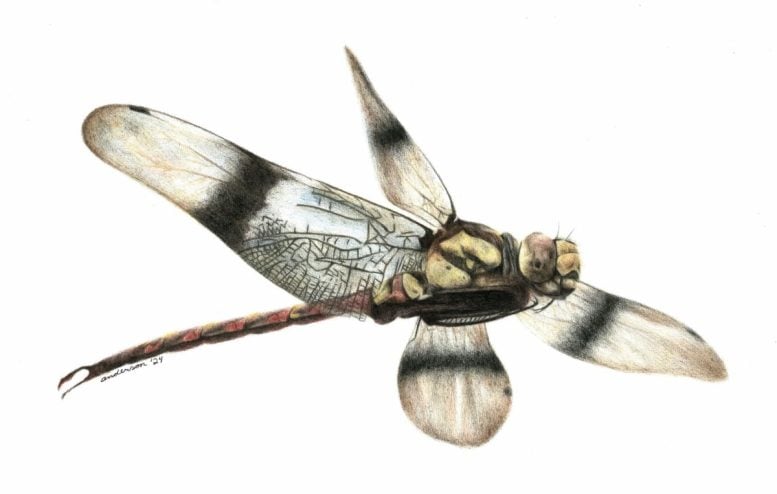
Discovery reveals a previously undocumented 30-million-year gap in dragonfly evolution.
For the first time in Canadian paleontology, a fossilized dragonfly wing from the Cretaceous period has been identified as a new species. Found in Alberta’s Dinosaur Provincial Park, it represents the earliest dragonfly fossil ever recovered from Canada’s dinosaur-era rock layers. The discovery, made by a McGill University research team, helps bridge a 30-million-year gap in the evolutionary record of dragonflies.
The specimen was unearthed in 2023 by a McGill undergraduate student during a vertebrate paleontology field course directed by Prof. Hans Larsson.
A surprising fossil discovery
“We were excavating an area where many leaf fossils had been found by cracking rocks,” said André Mueller, lead author of the study and a Master’s student in Larsson’s lab in McGill’s Department of Biology. “When the partial wing was uncovered, we were taken by surprise as we were not expecting to find any insects there.”
The team named the new species Cordualadensa acorni. Because of its remarkable distinction and unique anatomy, they even created a new family – Cordualadensidae – to classify it. They chose “acorni” for the species name to honor of University of Alberta lecturer John Acorn, entomologist and science communicator at the University of Alberta who has promoted the natural history of Alberta for decades, including with the TV show “Acorn, the Nature Nut.”
Adding to Alberta’s fossil record
“This is the first ever dinosaur-aged dragonfly found in Canada,” said Mueller. “Its wingspan was about the width of a human hand, and while small, it would have been an important part of the Cretaceous ecosystem—a tasty raptor snack, no doubt.”
The fossil was uncovered in the 75-million-year-old Dinosaur Park Formation, a site internationally recognized for its exceptional abundance of dinosaur remains. Until this discovery, however, evidence of insects in the formation was almost entirely absent. The only insect previously reported was a tiny aphid preserved in amber.
“This discovery not only doubles our knowledge of insects from the park, but also represents a completely unknown preservation method, impression fossils, for insect fossils in the area,” said Alexandre Demers-Potvin, a former Larsson PhD student and now a postdoctoral fellow in McGill’s Department of Biomedical Engineering. “We’ve now started finding more insect fossils by expanding where and how we search. The diversity of insect life during this time was likely much greater than we thought.”
The new fossil helps fill a major 30-million-year-old evolutionary gap. It’s the first known North American member of a large group of dragonflies called Cavilabiata. “The wing anatomy tells us this species was adapted for gliding; a trait associated with migratory dragonflies today and possibly a key to their success,” said Larsson. “This specimen also provides insight into what life was like in Canada 75 million years ago, adding an important new missing piece of the ecological puzzle of one of the most diverse dinosaur-bearing sites in the world.”
Reference: “New family of fossil dragonfly (Odonata, Cavilabiata) from the late Cretaceous (Campanian) Dinosaur Park Formation, Alberta, Canada” by André S. Mueller, Alexandre V. Demers-Potvin and Hans C.E. Larsson, 1 August 2025, Canadian Journal of Earth Sciences.
DOI: 10.1139/cjes-2024-0162
Funding for fieldwork was supported by an NSERC Discovery Grant (RGPIN/04370-2022) awarded to HCEL. This research was performed using the infrastructure of the Adaptable Earth Observation System, funded by the Quebec government, McGill University, and the Canadian Foundation of Innovation project 36146.
Never miss a breakthrough: Join the SciTechDaily newsletter.
7 Comments
The article does not give the name of the student who discovered the dragonfly wing fossil. This is a significant omission, in my opinion.
AGreed, Mueller identified it, but another member of the team handed the small rock to him, and said it needed a second look. Who was that? I would like to see the whole team named.
I have one I found in ky
There is no evolutionary record for one! There is not one living thing that shows anything evolving! Nothing! Out of all the fossil records showing anything changing from one thing to another, a butterfly is still a butterfly, dog a dog, etc etc.
And a dinosaur is a dinosaur, right. I really don’t see your point.. please explain.
I like the info about ancient times and history. It was interesting to read and to see evidence if authentic from the places that are found. Archaeological discoveries are not only fascinating but important to witness “As is “, when the team of archaeologists discovers something that was found and linking the parts that can be found all together.
Thank you for this articl e release, It does help a lot to get to know g the he region of places where there are some similarities found elsewhere. Thank you
You may have seen a horse fly, you may even have seen a house fly, but I bet you ain’t never seen a donkey fly!